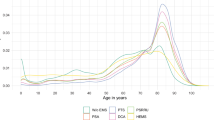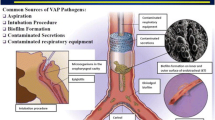Abstract
Purpose
To develop a measure of paediatric intensive care unit (PICU) efficiency and compare the efficiency of PICUs in Australia and New Zealand.
Methods
Separate outcome prediction models for estimating clinical performance and resource usage were constructed using patient data from 20,742 admissions between 2005 and 2007. A standardised mortality ratio was calculated using a recalibrated Paediatric Index of Mortality 2 model. A random effects length of stay (LoS) prediction model was used to provide an indicator of unit-level variation in resource use. A modified Rapoport-Teres plot of risk-adjusted mortality versus unit mean LoS provided a visual representation of efficiency. To account for potential differences in admission threshold, the calculation of performance measures was repeated on patients receiving mechanical respiratory support and compared to those estimated for all patients.
Results
The modified plot provides a useful tool for visualising ICU efficiency. Two units were identified as potentially inefficient with higher SMR and risk-adjusted mean LoS at the 95% level. One unit had a significantly lower SMR and significantly higher risk-adjusted mean LoS. The measures for both SMR and risk-adjusted mean LoS showed good agreement between all patients and those who received mechanical respiratory support.
Conclusion
There is significant variation in efficiency among PICUs in Australia and New Zealand. Two units were designated as inefficient and one unit was considered to be effective at the expense of high resource use. Application of these methods may help to identify inefficiencies in units located in other countries or regions.




Similar content being viewed by others
References
Hartwig J (2008) What drives health care expenditure?–Baumol’s model of ‘unbalanced growth’ revisited. J Health Econ 27:603–623
Institute of Medicine (IOM) (2006) Performance measurement: accelerating improvement. National Academy Press, Washington DC
Kirton OC, Civetta JM, Hudson-Civetta J (1996) Cost effectiveness in the intensive care unit. Surg Clin N Am 76:175–200
Rotondi AJ, Sirio CA, Angus DC, Pinsky MR (2002) A new conceptual framework for ICU performance appraisal and improvement. J Crit Care 17:16–28
Ward NS, Levy MM (2007) Rationing and critical care medicine. Crit Care Med 35:S102–105
Rapoport J, Teres D, Zhao Y, Lemeshow S (2003) Length of stay data as a guide to hospital economic performance for ICU patients. Med Care 41:386–397
Rothen HU, Stricker K, Einfalt J, Bauer P, Metnitz PG, Moreno RP, Takala J (2007) Variability in outcome and resource use in intensive care units. Intensive Care Med 33:1329–1336
Zimmerman JE, Kramer AA, McNair DS, Malila FM, Shaffer VL (2006) Intensive care unit length of stay: benchmarking based on acute physiology and chronic health evaluation (APACHE) IV. Crit Care Med 34:2517–2529
Jimenez R, Lopez L, Dominguez D, Farinas H (1999) Difference between observed and predicted length of stay as an indicator of inpatient care inefficiency. J Int Soc Qual Health Care 11:375–384
Straney LD, Clements AC, Slater A, Alexander J (2009) Quantifying variation of paediatric length of stay among intensive care units in Australia and New Zealand. Qual Saf Health Care 19:341–348
Rapoport J, Teres D, Lemeshow S, Gehlbach S (1994) A method for assessing the clinical performance and cost-effectiveness of intensive care units: a multicenter inception cohort study. Crit Care Med 22:1385–1391
Rothen HU, Takala J (2008) Can outcome prediction data change patient outcomes and organizational outcomes? Curr Opin Crit Care 14:513–519
Domínguez L, Enríquez P, Alvarez P, de Frutos M, Sagredo V, Domínguez A, Collado J, Taboada F, García-Labattut A, Bobillo F, Valledor M, Blanco J (2008) Mortality and hospital stay adjusted for severity as indicators of effectiveness and efficiency of attention to intensive care unit patients. Med Intensiva 32:8–14
Nathanson BH, Higgins TL, Teres D, Copes WS, Kramer A, Stark M (2007) A revised method to assess intensive care unit clinical performance and resource utilization. Crit Care Med 35:1853–1862
Ruttimann UE, Patel KM, Pollack MM (2000) Relevance of diagnostic diversity and patient volumes for quality and length of stay in paediatric intensive care units. Paediatr Crit Care Med 1:133–139
Ruttimann UE, Patel KM, Pollack MM (1998) Length of stay and efficiency in paediatric intensive care units. J Paediatr 133:79–85
Pollack MM, Getson PR, Ruttimann UE, Steinhart CM, Kanter RK, Katz RW, Zucker AR, Glass NL, Spohn WA, Fuhrman BP et al (1987) Efficiency of intensive care: a comparative analysis of eight paediatric intensive care units. JAMA 258:1481–1486
Slater A, Shann F, Pearson G (2003) PIM2: a revised version of the paediatric index of mortality. Intensive Care Med 29:278–285
Hosmer DW, Hosmer T, Le Cessie S, Lemeshow S (1997) A comparison of goodness-of-fit tests for the logistic regression model. Stat Med 16:965–980
Bland JM, Altman DG (1986) Statistical methods for assessing agreement between two methods of clinical measurement. Lancet 1:307–310
Lee AH, Wang K, Yau KK, McLachlan GJ, Ng SK (2007) Maternity length of stay modelling by gamma mixture regression with random effects. Biom J 49:750–764
Mann HB, Whitney DR (1947) On a test of whether one of two random variables is stochastically larger than the other. Ann Math Stat 18:50–60
Tu JV, Mazer CD (1996) Can clinicians predict ICU length of stay following cardiac surgery? Can J Anesth 43:789–794
Mittlbock M, Heinzl H (2002) Measures of explained variation in gamma regression models. Commun Stat Simul Comput 31:61–73
Acknowledgements
We thank the intensivists, research nurses and other staff in the participating ICUs for their data contributions. The first author’s PhD stipend is funded by the University of Queensland. The ANZPIC Registry is supported by the Australian and New Zealand Intensive Care Society, the Ministry of Health (New Zealand), and State and Territory Health Departments through the Australian Health Ministers’ Advisory Council.
Conflict of interest statement
None.
Author information
Authors and Affiliations
Corresponding author
Additional information
For the ANZICS Paediatric Study Group.
Rights and permissions
About this article
Cite this article
Straney, L.D., Clements, A., Alexander, J. et al. Measuring efficiency in Australian and New Zealand paediatric intensive care units. Intensive Care Med 36, 1410–1416 (2010). https://doi.org/10.1007/s00134-010-1916-3
Received:
Accepted:
Published:
Issue Date:
DOI: https://doi.org/10.1007/s00134-010-1916-3




